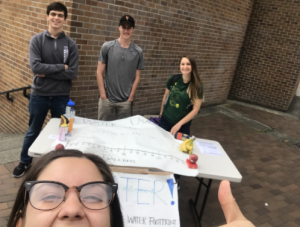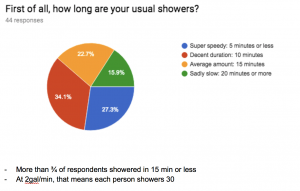Water is one of earth’s most precious resources, and it is dwindling at a rapid rate. In an industrialized world that demands water for nearly every activity, this spells disaster. Edging closer to the brink of a global water crisis as each day passes, my group action project wanted to confront the personal issues that contribute to this hostile climate: virtual water, water footprint, and water usage.
Armed with the purpose of educating our student community on campus about their water footprint and water consumption habits, we decided to set up a table on Red Square and act as an instructional body focused on eliminating common misconceptions about water. By creating interactive posters displaying the difference between assumed water usage versus actual water usage, passersby were able to learn that the scope of their water impact is far beyond what many assume it be. Many students were shocked to learn that their water usage fluctuates depending on their geographic location, and that the virtual water in the food we eat causes personal water footprint to skyrocket. Although the table and the interactive materials were the most integral and impactful pieces of our project, we also passed out educational flyers to everyone we talked to in hopes that they would take the information they learned at our table and share it with their friends (or at least recycle the paper). We also sent out a quick survey to gather data from UW students about their personal water usage and if they thought water was important. Surprisingly, nearly everyone polled agreed that issues surrounding personal water footprint were important! We were also able to create connections between the local and global through the project. By discussing the water footprint in Seattle and the state of Washington, we made our stance applicable to local issues. By discussing the water footprint in the United States, we enlarged the scope of water consumption to a national issue. And by discussing how globalization has influenced water consumption in developed countries compared to undeveloped, we made water footprint a global and glaringly apparent issue.
Our group was inspired by our lecture on virtual water, which described different ways to “drink your water” through different meats, vegetables, and beverages. In hopes of translating that in-class lecture into our project, we showcased apples, bananas, and tea alongside a note on how much water it takes to produce it. By bringing in a tangible example of what we talked about both in lecture and at our table, we hoped to make the abstract idea of virtual water more concrete. We also discussed the impacts that industrialization and globalization have on water, as both concepts were integral to our course. With an increase of industrialization comes an increase in water consumption, and with emphasis on rapid globalization comes with a decrease of water available to developing nations.
Although this project was rewarding in the end, I definitely had my qualms at the beginning. I was worried that my group wouldn’t mesh well together, or that we wouldn’t finish the project on time. Our project definitely had room for improvement due to scheduling and miscommunication difficulties, but I am beyond proud of how it turned out. Being able to educate students on campus about an issue that is so globally influential is truly a blessing. I was able to grow in my interpersonal skills, as well as learn how to be both a leader and a team player. Leaving an impact on campus through our project made the process so worthwhile, and I would do it again in a heartbeat.
If you have any questions about our project, feel free to comment below! I’d love to answer any inquiries about a topic I am so passionate about.

Our project!


Statistics from our survey
